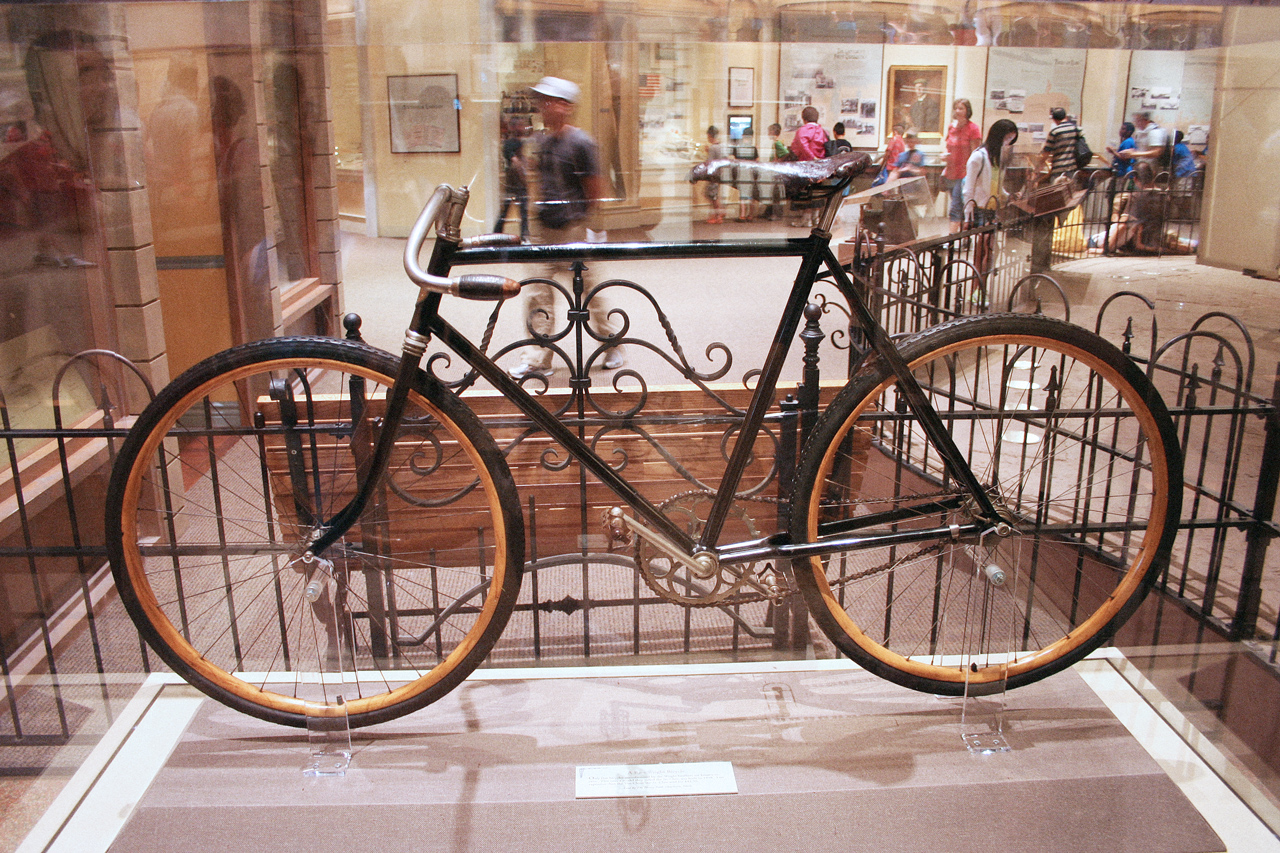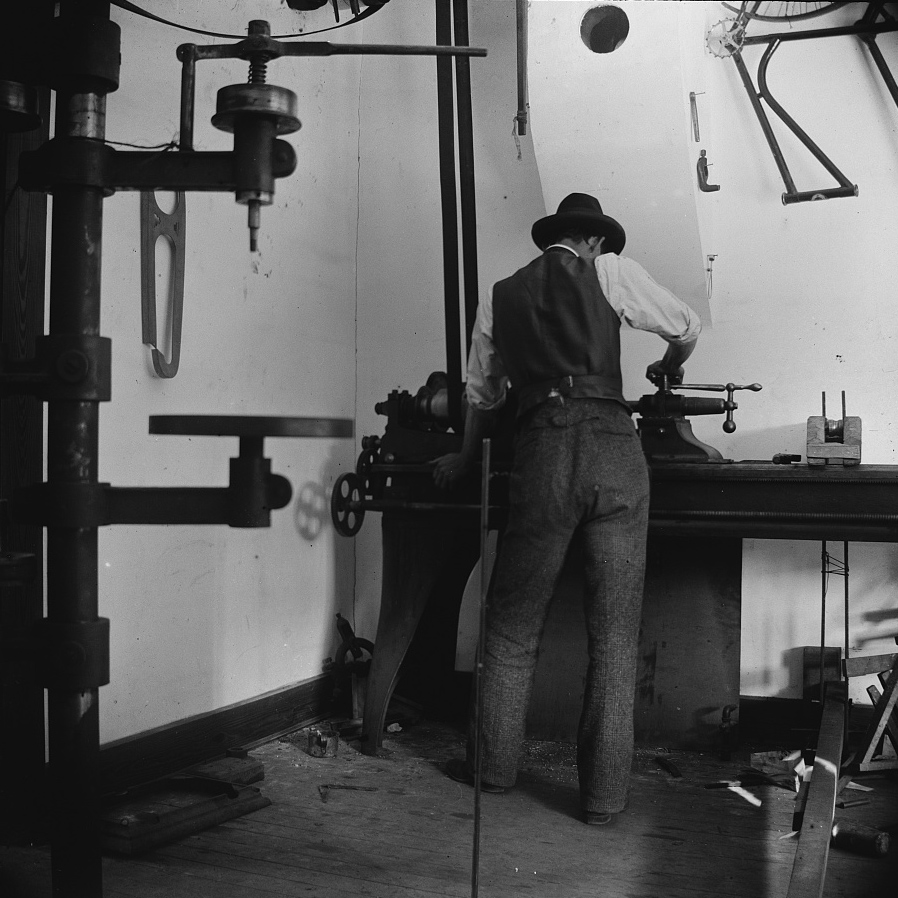Many aviation pioneers—including the Wright Brothers—were also dedicated cyclists. Here's what they learned from bike design.
In the early 20th century, many in the scientific establishment insisted that a true flying machine was physically impossible. Nevertheless, cyclists could already "fly" at an altitude of five feet or so. The owners of "mechanical horses," as they were sometimes known, had no need of flying machines. As one magazine editor in 1894 put it, "There be steeds that neither eat nor drink, yet Bucephalus in all his glory could not go as fast or as far as they. Shall we presently fly? Why fly? Surely we are going fast enough now."
To wit, many bikes even had the word "flyer" in their names: White Flyer, Belleville Flyer, Flying Yankee. Bicycle advertisements featured riders coasting merrily through the air, and one ad showed a non-rider plummeting. This ad depicted Darius Green, a popular children’s book character known for building his own Icarus-style flying machine—with Icarus-style results. "Darius Green would never have sighed for a flying-machine if he had seen a ’95 Victor bicycle," the ad copy noted snidely.
Ministers even likened cycling to heavenly flight. "We are riding upon the wind," preached one Brooklyn pastor in May 1895. "What Job did in his figurative escape from trouble, riding on the air, the weary and confined toiler at the desk and counter performs when he shuts the door behind him, comes forth into God’s pure air, and mounts his scientific angel."
So whereas many respectable scientists saw heavier-than-air flight as a fantasy, some cyclists felt it was the natural next step. Just as the bicycle had created a demand for powered land transportation, it created a thirst for powered flight.
Who would create these revolutionary new vehicles? The same people who created the last ones, many thought. "The flying machine problem is liable to be solved by bicycle inventors," wrote a Binghamton newspaper editor in 1896. "The flying machine will not be in the same shape, or at all in the style of the numerous kinds of cycles, but the study to produce a light, swift machine is likely to lead to an evolution in which wings will play a conspicuous part."
The bicycle maker Charles Duryea designed a pedal-powered helicopter, though he probably never built it. Said Duryea of the 200-pound machine he imagined: "It is right in our line; is in fact really a development of the bicycle."
There was logic to the editor’s prediction that bicycle mechanics would solve the mystery of flight. The bicycle introduced humans to the sensation of flying; its technological development created a precedent for the process of inventing the airplane. Rather than tinker in isolation and emerge with complete, radically new devices to test—as some visionary or crackpot aeronautical inventors had been doing—bicycle manufacturers competed, collaborated, copied each other, and moved together inch-wise toward a consensus on how to build the lightest, fastest, and safest vehicles.

In other words, the bicycle evolved. The German gliding pioneer Otto Lilienthal, whom Wilbur Wright, the older Wright Brother, considered "without question the greatest of [our] precursors," argued in 1896 that the development of flying machines should follow the same pattern. Through methodical experimentation, Lilienthal had developed the first controllable hang glider and could travel more than 800 feet through the air. He urged other would-be aviators to try to best him. "The greater the number is of such persons who have the furthering of flying and the perfecting of the flying apparatus at heart the quicker we shall succeed in reaching a perfect flight," he wrote in an (awkwardly translated) article in theAeronautical Annual, a Boston journal for would-be aviators. "The rivalry in these exercises cannot but lead to a constant perfecting of the apparatus, the same as, for instance, is the case with bicycles."
The journal’s editor, James Means, made an even stronger link between the two technologies. "The admirable wheel of to-day is the product of more than eighty years of careful thought and experiment," he wrote. "If the world is to make rapid progress in manflight it must have a much greater confidence in the value and importance of the Lilienthal soarer than it had in the wonderful balancing wheel of 1816."
Sadly, Lilienthal died in a gliding accident in August 1896. It was news of his death that reignited the Wrights Brother's childhood interest in aviation. After reading all the aeronautical literature he could get his hands on, Wilbur Wright wrote to the Smithsonian Institution, requesting more material. "I believe that simple flight at least is possible to man," the letter read, "and that the experiments and investigations of a large number of independent workers will result in the accumulation of information and knowledge and skill which will finally lead to accomplished flight."

At the time, most aeronautical experimenters—including Samuel P. Langley, then secretary of the Smithsonian—sought to build airplanes that would automatically balance themselves in buffeting winds. Though scientists had long believed that air moved pretty much like water, with uniform waves and currents, Langley had revealed in 1893 that the atmosphere is much more chaotic than the ocean. Within each puff of wind are eddies, hollows, shears, and other unpredictable movements that can quickly flip or stall a floating object.
For Langley and like-minded researchers, the answer was to design a flying machine that could right itself like a punching clown. No human pilot could be expected to compensate for wind gusts the way birds do, they believed. As Joseph Le Conte, the president of the American Association for the Advancement of Science and an aviation skeptic, wrote in 1894, "In the bird we have the last perfection of skill acquired by constant practice and inherited through successive generations. Even if the science of aviation were perfect, the exquisite art necessary to manage such a machine seems almost hopelessly unattainable."
It seemed Le Conte was right. The self-balancing airplane proved elusive, and its pursuit led to some spectacular crashes, including the catapulting of Langley’s four-winged, 750-pound "Aerodrome" straight into the Potomac River on December 8, 1903, nine days before the Wrights first flew.
The Wrights, by contrast, had an insight that came straight from cycling. They understood that a plane didn’t need to be stable. Like a bicycle, it could be inherently unstable and could be flown in the same way a bicycle is "flown": by a rider making constant, tiny, unconscious adjustments. "It has been a common aim of experimenters with the aëroplane to solve the problem of equilibrium by some automatic system of balancing," stated the brothers in a 1908 "as told to" story in McClure’s. "Our idea was to secure a machine which, with a little practice, could be balanced and steered semi-automatically, by reflex action, just as a bicycle is." The Wrights studied the movements of soaring birds and designed a steering system that copied the way birds torque the tips of their wings when they turn. In the Wright Flyer, the pilot steered by pushing on levers that warped the plane’s wings. (Wilbur first got the idea for the wing-warping system while idly twisting an empty inner-tube box.)

And like a cyclist, a pilot would need practice, the Wrights realized. "If you are looking for perfect safety, you will do well to sit on a fence and watch the birds," Wilbur said in 1901, "but if you really wish to learn [to fly], you must mount a machine and become acquainted with its tricks by actual trial." This is why the brothers built a working glider before they even tried to add an engine: they wanted to learn how to fly. In 1909, after the Wrights had publicized their invention and other aviators had built working planes of their own, one journalist compared the airplane pilot to "the bicycle-rider on a slack wire, armed with a parasol"; like the cyclist, "he must exercise incessant vigilance lest he lose his balance." But the Wrights had developed such skill, another journalist wrote, that they "are often able to remove their hands from the levers, and glide along like the bicyclist who leans back and lets go of the handle bars."
The Wright brothers were not the only wheelmen to succeed in aviation. Lilienthal was an enthusiastic cyclist who once built a high-wheel tricycle rickshaw with his brother. Glenn H. Curtiss, an early Wright competitor who pioneered the use of seaplanes, had been a bike shop owner and bicycle racer.

Many early barnstormers were cycle racers first. According to Tom D. Crouch, the author ofThe Bishop’s Boys: A Life of Wilbur and Orville Wright and several other books on early flight, the bicycle prepared these aviators both practically and psychologically. Along with introducing people to the sensation of swift flight and proving that any ordinary person could develop balancing skills, the bicycle afforded an unprecedented sense of independence and control that translated into the confidence to fly, Crouch says.
People would no doubt have figured out how to fly eventually even without the bicycle, but it was the bike that made it happen when it did and made America the birthplace of aviation.
Excerpted with permission from The Mechanical Horse: How the Bicycle Reshaped American Life, by Margaret Guroff (University of Texas Press, 2016).
Natilus announced a strategic partnership with MONTE Aircraft Leasing. MONTE will provide leasing and financing options for the Kona aircraft to Natilus customers, making the path towards sustain...
NAV CANADA and CAE have signed a strategic agreement to increase training capacity for crucial air traffic services professionals. Under this first-of-its-kind partnership in Canada, CA...
The development of the new Do228 NXT by the German aircraft manufacturer General Atomics AeroTec Systems is progressing well. The new batch is based on the existing Dornier 228 with glass co...
Garmin expanded coverage of the Garmin Navigation Database to now include Europe. Previously available to aircraft owners and operators in the Americas, the Garmin Navigation Database delivers a...


